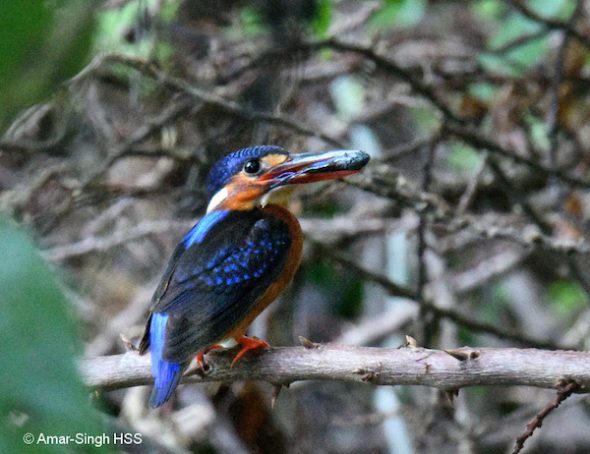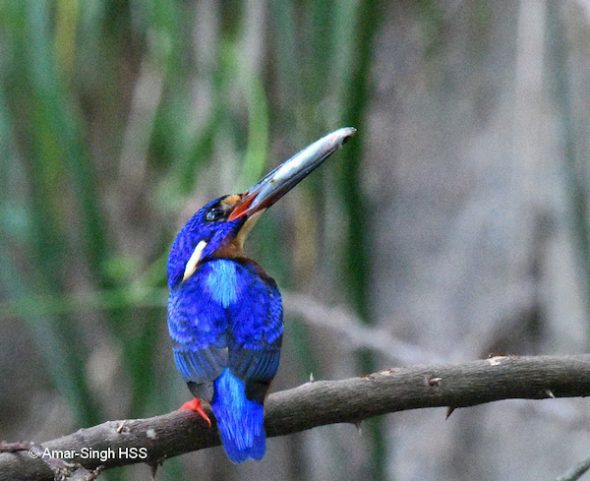
I was alerted to a pair of nesting Blue-eared Kingfisher (Alcedo meninting meninting) by a colleague and dropped by to watch them for a brief period, using the car as a hide. The nest was located 0.5-0.7 meters above ground level on the side of a mud embankment. The breeding pair were there feeding the young. Food was small fish presented head first.
What was odd of the pair was that the female partner was immature (above). Note the rufous behind the eye (not “blue-eared”) that supports the immature status. The coral-red, especially to the lower aspect of the mandible support it being female. The male was a mature adult (below). The area was dark and ISO for these images were 32-40,000.

I asked myself why an immature bird should be breeding and would like to offer some suggestions/reasons:
- Could there be Delayed Plumage Change?
Could the plumage change for the female Blue-eared Kingfisher take more than one year to become fully mature? That is, ‘adult breeding female’ birds may still sport immature plumage? I have no evidence for this currently. I searched on line for “Blue-eared Kingfisher nest” and “Blue-eared Kingfisher breeding” to see if others had seen such behaviour. Phiphat Suwanmon (2016), Shirley Ng (2011) and Francis Yap (?date) have posted pairs nesting, an adult male with an immature female. So my observation is not isolated and delayed plumage change is a possibility.
- Could this be a Breeding Helper?
Some birds have supportive breeding systems where helpers (usually first year birds) care for non-descendant offspring. Some kingfishers have breeding helpers including the Laughing Kookaburra (Dacelo novaeguineae), Blue-winged Kookaburra (Dacelo leachii), Pied Kingfisher (Ceryle rudis) and Forest Kingfisher (Todiramphus macleayii). I searched for any information or observation on this regarding the Blue-eared Kingfishers but could not find any. The Blue-eared Kingfishers I have personally observed nesting on this and previous occasions have always been a single pair.
- Could this be an early warning signal of population decline (dying species)?
Ferrer et al (2003) offer an interesting paper with good evidence of “proportion of immature breeders as a reliable early warning signal of population decline” in a raptor species. They say in the discussion that “Birds in immature plumage are capable of breeding, but do not normally do so because any gaps in the territorial system are usually filled by older birds. However, when the death rate is increased, more territories become vacant, enabling younger birds to breed (Newton, 1979). Balbontin et al. (2003), proposed two possible causes of an increase in immature breeders. First, it could be due to an increase in mortality rate, either immature or adult (Valverde, 1960; Newton, 1979; Novelletto and Petretti,1980; Ratcliffe, 1980; Steenhof et al., 1983) or it could be due to an increase in the availability of resources such as nest sites or food supply, such as occurs when populations are increasing (McGowan, 1975; Newton, 1976; Wyllie and Newton, 1991; Brommer et al., 1998).”
I have no evidence that Blue-eared Kingfishers are declining locally and their international red data status is “least concerned”. There is also no increased abundance of food, even as the environment gets more damaged. Globally of course all birds are facing a challenge for survival.
Appreciate any opinions.
References:
- Phiphat Suwanmon (2016). Blue-eared Kingfisher (Breeding). YouTube video. https://www.youtube.com/watch?v=k2t4kGPzS2c
- Shirley Ng (2011). http://lifes-indulgences.blogspot.com/2011/04/wildlife-drama-saga-of-blue-eared.html
- Francis Yap. Singapore Birds Project: Blue-eared Kingfisher. Image is posted as “Blue-eared Kingfisher pair” suggesting mating. https://singaporebirds.com/species/blue-eared-kingfisher/
- Miguel Ferrer, Vincenzo Penteriani, Javier Balbontín, Massimo Pandolfi (2003). The proportion of immature breeders as a reliable early warning signal of population decline: evidence from the Spanish Imperial Eagle in Doñana. Biological Conservation 114(3):463-466.
Amar-Singh HSS (Dato’ Dr)
Ipoh, Perak, Malaysia
Location: Ipoh, Perak, Malaysia
Habitat: Fringe of the city
Date: 1st January 2019
Equipment: Nikon D500 SLR with Tamron SP 150-600mm f/5-6.3 Di VC USD, handheld








